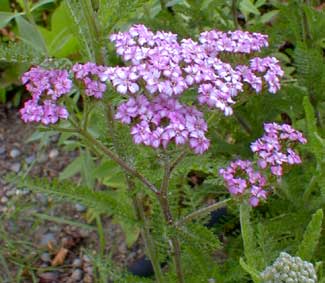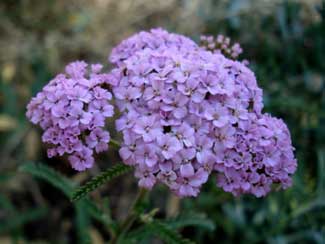
'Lavender Deb'
Yarrow
"Spirit of lakes & seas & rivers,--
Bear only perfumes & the scent
Of healing herbs to just men's fields."
-Henry David Thoreau
(1817-1862)
(1817-1862)
Achillea millefolium 'Lavender Deb' grows one to two feet high in full flower. The blooms are a pastel pinkish purple. The spreading clump can eventually reach two or three feet wide, & will likely need to be dug up & divided about every third or fourth year.
The flowers aren't much different than the old standard 'Lavender Beauty,' especially as the color on each is variable over the life of each raceme. But foliage clumps for 'Lavender Deb' are more compactly leafy than the majority of yarrows, & it's a bit shorter than most. They are therefore less often tippy than are taller yarrows, although a hard rain can cause a dense clump to "part" & reveal a scruffy center. If it does become homely, a severe sheering right down to the basal leaves will induce fresh growth as good as new.
 The basal leaves attempt to be evergreen through winter in our mild climate. The rest of the plant dies back though stems may linger. Before spring, it needs to be trimmed nearly to the ground, both for its general looks, & so that new spring leaves are not competing with worn-out winter-damaged leaves for space in a tight clump.
The basal leaves attempt to be evergreen through winter in our mild climate. The rest of the plant dies back though stems may linger. Before spring, it needs to be trimmed nearly to the ground, both for its general looks, & so that new spring leaves are not competing with worn-out winter-damaged leaves for space in a tight clump.It focuses more of its energy on producing blooms, thus spreads its grey-green ferny clump a little less rapidly than some other varieties, especially if planted in poor light soil in which it blooms best. A rich acidic soil will make it leafier & swifter to clump wider & wider, but it'll be floppy & won't be improved for looks or flowering strength.
It blooms all summer with occasional deadheading, & can rebloom well into autumn. When there is a late-summer pause in its flowering, it should be trimmed down to near the basal leaves, to induce reflowering.
When flowers are brought into the house for bouquets, it is nice to retain many of the leaves on the stems, as they have a pleasant spicy odor. The corymbs can also be dried for winter bouquets.
The dried leaves & flowers of yarrows were traditionally saved to use as a spice & as a folk-remedy. To get the strongest medicinal value, the leaves were supposed to be harvested just before bloom, & the blooms were later harvested as well. As a tea it was credited as a powerful health tonic good for everything that ails ya, & medieval midwives recommended it as an aid to relieve excess menstrual bleeding.
It's even today sold by crackpot herbalists for every conceivable illness, but it is not sensibly recommendable. Some of the traditional claims for it do have a little scientific support, as yarrow has many active chemical compounds that might well have legitimate medicinal value. But users are even more likely to just be allergic to it, & prolongued heavy use can cause photosensitivity & other side-effects. It will effect mothers' milk as greatly as it does cow's milk by making the milk taste awful, so use by pregnant or nursing mothers is most unwise.
It is as yet unknown if & to what degree it could alter or negate the more certain value of prescription drugs. If you insist on self-medicating for random ailments, be sure to tell your doctor what alternative-medicines you're gobbling down, before he writes out your next prescription, lest he end up helping you kill yourself in pursuit of perfect health.
Externally it is somewhat safer, functioning as an astringent & antiseptic & mosquito repellant. If pressed against wounds it is said to stop bleeding & pain & fascilitate healing. Belief in yarrow's healing properties goes into great antiquity in China & Europe, even to a mythological age.
The genus name is after the Greek hero Achilles, who learned women's herblore from his mother who raised him as a girl, so he knew to use yarrow on the battlefield to stop the bleeding of his fellow warriors' wounds. But should you elect to emulate Achilles, bear in mind it can as easily induce allergic skin reactions.
Apart from an adult beverage additive, yarrow is not otherwise FDA approved for commercial use as a food flavoring & is not permitted to be sold as a powdered spice due to its potential toxicity. Yet it is easily obtainable semi-legally over the world wide web, or from one's own garden, for sundry uses wise or unwise.
When used sparingly, it does make an acceptible culinary herb, losing the mild toxicity when cooked, so is an acceptible substitute for sage in cooked dishes. The leaves can be boiled in soups or baked as an added ingredient for spinach recipes, but perhaps best left off salads because the thujone content is toxic until cooked.
Continue to:
'Summerwine' Yarrow